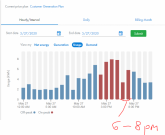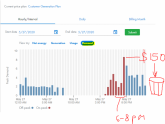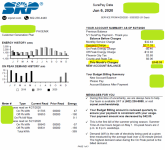Hi. I'm from Phoenix, AZ with 12.96kW grid-tied system up and running. It has 5 strings of panels and two SMA grid-tied inverters working in parallel. They are AC coupled before solar meter. It's a standard design recommended by SRP (utility company) published on their Web-site
I'm on "Customer Generation" E-27 plan from SRP with peak time 2pm-8pm where demand fees apply. Monthly bill consists of three parts:
1. Monthly NET amount "Per kW/hr" (separately for "off peak" 8pm to 2pm and "on peak" from 2pm to 8pm)
2. Flat monthly "Service fee"
3. "Demand fee" which is calculated for highest peak of electricity consumption "on peak" time from 2pm to 8pm during billing month
My system covers almost 100% of daily electricity needs. In some months I have even negative net balance of kilowatt-hours consumed. Between 2-5pm "on peak" time consumption and peak demand is almost fully covered with solar generation and thus not countable
However from 5pm to 8pm sun gets weak or there is no sun. SRP charges harsh fees for demand during peak time in summer: $17.51 for each kW below 10 and $33.59 for each kW above 10. Hence demand charges jump to $150-180 per month for occasional 10-12 kW spikes happening even one time per month. So demand fee is about 90% or more of my monthly electrical bill and I'm looking for technical solutions to mitigate it
The biggest energy hog is central 5 ton A/C unit consuming about ~7kW of electricity. It's running ~12 hours daily around o'clock to beat the triple digits heat in Arizona. Other large appliances are: laundry dryer, oven/stove and several smaller A/C units in different rooms
I looked at Demand Control systems "Smart Panel 3000" and "Brayden Automation Energy Sentry". They are very expensive. However basically they can help only with periodic turning off A/C and other major appliances when demand is high. This is not a possible solution for my situation. I cannot allow my house to get hotter by adjusting A/C for higher temperature even for less than hour due to health issues. Also it's very hard to control who in the family wants to cook something in the oven, dry laundry or turn on their own bedroom A/C units during peak time
So I'm looking for possible solution to add some battery storage to my system. Possibly it can work like this:
* 8pm-2pm - batteries charging during off-peak hours as electricity if free during that time. It's either produced by solar or drawn from utility. Net balance is fully offset by solar generation and always negative in my bill for these hours. Even if there is no sun in night time, electricity is still free as daily generation creates reserve with net metering to be used in night time
* 2pm-5pm - "On-peak" time when solar generation typically covers my entire demand. It's not reasonable to charge batteries during that time and more beneficial to sell excessive energy back to utility for higher "on-peak" cost
* 5-8pm - "On-peak" time when solar generation is not sufficient to cover 100% of demand. But it covers from 100% of it at 5pm to zero when sun goes down. At this time house should consume still produced solar electricity first and then the rest of energy should be supplied from batteries avoiding expensive utility-provided energy with demand charges. However utility shouldn't be disconnected via transfer switch as starting current of A/C unit is about 140Amps and inverters don't have sufficient power to provide it even for a couple of seconds. So those starting A/C peaks should be covered from utility
I was thinking about adding AC coupled hybrid inverter with battery backup and possibly another solar string with it to my system. That should be a third inverter. I looked at several models of such inverters from SRP-approved list (mainly "Schneider Electric"). And they all work different way than described above. All of them have built-in transfer switch and loads should be connected after it. In such case loads use solar energy and then switch to battery energy if it's not sufficient or grid is down. Inverter and batteries capable to produce 140Amps/240V AC for starting HVAC unit and running it completely from batteries will be very expensive
So ideally system should operate such way:
*Hybrid inverter/charger be AC coupled with other two existing inverters before solar meter
*Batteries charged only at scheduled time 8pm-2pm. It can be either from its own solar string or from AC side - doesn't matter. It might even NOT have its own solar string and be used only as purely battery charger/inverter
*No transfer switch. Loads should still go from main electric panel where utility power is combined with solar power
*System should measure demand from utility at any particular moment on-peak time and supply the balance between demand and solar generation to common connection by using batteries
In such case solar energy would always have priority for consumption and demand from utility stay "zero" unless batteries fully exhausted ans loads start working just from utility. HVAC starting current will be covered from powerful utility connection not overloading inverters
I couldn't find any model of hybrid inverter capable for such operation. Can anybody suggest one?
The only possible solution I see is DIY with 200-550V battery bank hooked up directly to MPT channel of grid-tied inverter. Or same DC voltage provided from 48V battery bank via another "off-grid" inverter/charger and rectifier to be fed into MPT chanel of grid-tied inverter. However in such case I need a demand-measuring sensor on utility line, PWM to control power supplied from battery bank to MPT of inverter and computer to control power supplied by PWM based on momentary demand and time of day. Otherwise the MPT will always try to draw the maximum power that battery can supply quickly exhausting it
Any ideas?
I'm on "Customer Generation" E-27 plan from SRP with peak time 2pm-8pm where demand fees apply. Monthly bill consists of three parts:
1. Monthly NET amount "Per kW/hr" (separately for "off peak" 8pm to 2pm and "on peak" from 2pm to 8pm)
2. Flat monthly "Service fee"
3. "Demand fee" which is calculated for highest peak of electricity consumption "on peak" time from 2pm to 8pm during billing month
My system covers almost 100% of daily electricity needs. In some months I have even negative net balance of kilowatt-hours consumed. Between 2-5pm "on peak" time consumption and peak demand is almost fully covered with solar generation and thus not countable
However from 5pm to 8pm sun gets weak or there is no sun. SRP charges harsh fees for demand during peak time in summer: $17.51 for each kW below 10 and $33.59 for each kW above 10. Hence demand charges jump to $150-180 per month for occasional 10-12 kW spikes happening even one time per month. So demand fee is about 90% or more of my monthly electrical bill and I'm looking for technical solutions to mitigate it
The biggest energy hog is central 5 ton A/C unit consuming about ~7kW of electricity. It's running ~12 hours daily around o'clock to beat the triple digits heat in Arizona. Other large appliances are: laundry dryer, oven/stove and several smaller A/C units in different rooms
I looked at Demand Control systems "Smart Panel 3000" and "Brayden Automation Energy Sentry". They are very expensive. However basically they can help only with periodic turning off A/C and other major appliances when demand is high. This is not a possible solution for my situation. I cannot allow my house to get hotter by adjusting A/C for higher temperature even for less than hour due to health issues. Also it's very hard to control who in the family wants to cook something in the oven, dry laundry or turn on their own bedroom A/C units during peak time
So I'm looking for possible solution to add some battery storage to my system. Possibly it can work like this:
* 8pm-2pm - batteries charging during off-peak hours as electricity if free during that time. It's either produced by solar or drawn from utility. Net balance is fully offset by solar generation and always negative in my bill for these hours. Even if there is no sun in night time, electricity is still free as daily generation creates reserve with net metering to be used in night time
* 2pm-5pm - "On-peak" time when solar generation typically covers my entire demand. It's not reasonable to charge batteries during that time and more beneficial to sell excessive energy back to utility for higher "on-peak" cost
* 5-8pm - "On-peak" time when solar generation is not sufficient to cover 100% of demand. But it covers from 100% of it at 5pm to zero when sun goes down. At this time house should consume still produced solar electricity first and then the rest of energy should be supplied from batteries avoiding expensive utility-provided energy with demand charges. However utility shouldn't be disconnected via transfer switch as starting current of A/C unit is about 140Amps and inverters don't have sufficient power to provide it even for a couple of seconds. So those starting A/C peaks should be covered from utility
I was thinking about adding AC coupled hybrid inverter with battery backup and possibly another solar string with it to my system. That should be a third inverter. I looked at several models of such inverters from SRP-approved list (mainly "Schneider Electric"). And they all work different way than described above. All of them have built-in transfer switch and loads should be connected after it. In such case loads use solar energy and then switch to battery energy if it's not sufficient or grid is down. Inverter and batteries capable to produce 140Amps/240V AC for starting HVAC unit and running it completely from batteries will be very expensive
So ideally system should operate such way:
*Hybrid inverter/charger be AC coupled with other two existing inverters before solar meter
*Batteries charged only at scheduled time 8pm-2pm. It can be either from its own solar string or from AC side - doesn't matter. It might even NOT have its own solar string and be used only as purely battery charger/inverter
*No transfer switch. Loads should still go from main electric panel where utility power is combined with solar power
*System should measure demand from utility at any particular moment on-peak time and supply the balance between demand and solar generation to common connection by using batteries
In such case solar energy would always have priority for consumption and demand from utility stay "zero" unless batteries fully exhausted ans loads start working just from utility. HVAC starting current will be covered from powerful utility connection not overloading inverters
I couldn't find any model of hybrid inverter capable for such operation. Can anybody suggest one?
The only possible solution I see is DIY with 200-550V battery bank hooked up directly to MPT channel of grid-tied inverter. Or same DC voltage provided from 48V battery bank via another "off-grid" inverter/charger and rectifier to be fed into MPT chanel of grid-tied inverter. However in such case I need a demand-measuring sensor on utility line, PWM to control power supplied from battery bank to MPT of inverter and computer to control power supplied by PWM based on momentary demand and time of day. Otherwise the MPT will always try to draw the maximum power that battery can supply quickly exhausting it
Any ideas?










